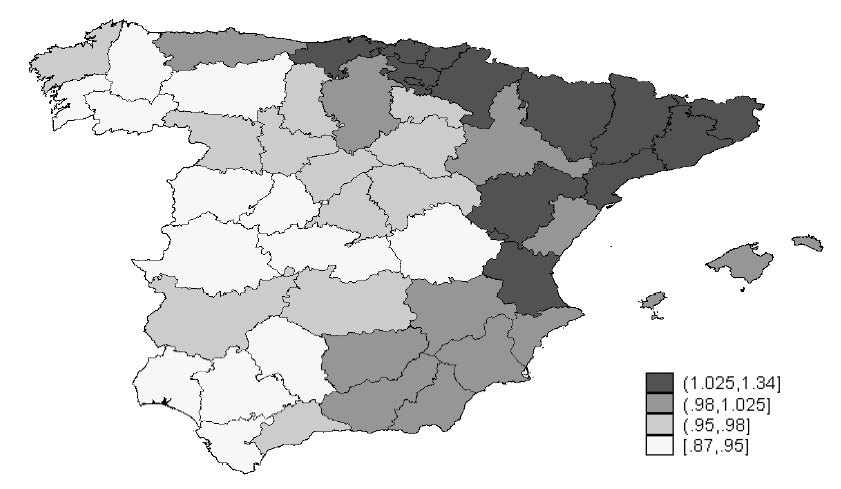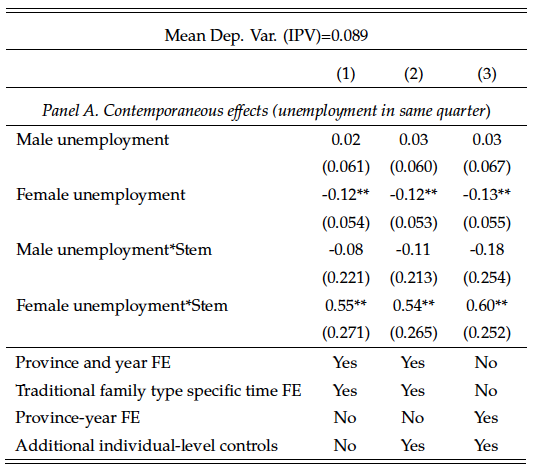Men with traditional views about the appropriate roles of women and men use violence to redress their masculine identity as breadwinners
Whenever an office of labor statistics announces a decrease of the unemployment rate, it is all about the economy improving. Yet there is a group of people for whom lower unemployment is not necessarily good news. In the BSE Working Paper No. 963 “Unemployment and Intimate-Partner Violence: A Gender-Identity Approach”, Ana Tur-Prats shows that for partners of men with traditional views about gender roles, lower female unemployment might increase intimate-partner violence.
A gender identity approach
The argument goes as follows. From an identity perspective, people feel better-off when their actions conform to the social norm, and worse-off when they fail to follow the role assigned by society to the category they belong.
In terms of gender roles, the traditional social norm states that men should be the main household providers. When female unemployment decreases relative to male unemployment, men can feel that they are no longer fulfilling with their role. As a result, they might react by inflicting violence to reinstate their masculine identity. This should not happen when both women and men are expected to contribute to the household income, as better job opportunities for women do not pose a threat to the role assigned to men.
Stem vs nuclear family: the mother-in-law effect
To distinguish between men with and without traditional views about gender roles, Ana Tur-Prats focuses on two family structures historically found in Spain: stem and nuclear families. In stem families one child remains in the parental household together with his spouse and children. In nuclear families all children leave the household upon marriage.
In stem families, therefore, the young wife lives together with her mother-in-law, which reduces her burden of household work and frees up her time for non-domestic work. This increased female contribution to family subsistence fosters an egalitarian social norm in where both men and women are expected to contribute tohousehold income. In contrast, in nuclear families the young wife is responsible for all household work. As a result, women’s activities are restricted to the domestic sphere while men are regarded as the main earners or breadwinners.
Social norms persist over time
These two family types prescribed different social norms that persist even after the customary family type is no longer prevalent. The following figure shows family types in Spain in 1860, computed as the average number of married and widowed women per household at the province level. The values range from 0.87 to 1.34. Higher values indicate higher prevalence of the stem family pattern.

Source: Own calculations using 1860 census data. For each province, I compute the average number of married and widowed women in the household, as a measure of family structure. Values range from 0.87 to 1.34, with an average of 1. Provinces shown in darker grey are provinces where the average number of widowed and married women in the household is higher and, consequently, where the stem family is more prevalent
Even after the stem family disappeared, people living in regions where this type of family was socially predominant are nowadays less likely to think that it is problematic that a wife earns more money than her husband.
Intimate partner violence and unemployment in Spain
Data on family types are matched with data on intimate-partner violence from four cross-sectional surveys on violence against women in Spain. The surveys were conducted in 1999, 2002, 2006 and 2011, and asked every woman how often her intimate partner does not allow her to see her friends or family, takes her money, threatens her, decides what she can or cannot do, insists on having sex even if she does not want to, shoves or beats her, and/or belittles her believes, among other behaviors. On average, during this period, according to this definition 8.95% of women were abused by their partners.
For each of these periods, the author also computed the unemployment rate by gender, age group and province, using the Active Population Survey of the Spanish Institute of Statistics. The average unemployment rate between 1999 and 2011 was 14.6%, and was higher for women (18%) than for men (12%).
In provinces with traditional gender roles a decrease in female unemployment increases violence
With these data the author finds that in provinces with traditional gender roles, a decrease in female unemployment relative to male unemployment is associated with an increase in intimate-partner violence. The following table shows that in provinces with high prevalence of nuclear families in the past, a 1 percentage point increase in own-age female unemployment is associated with a 0.12 percentage points decrease in intimate-partner violence. The effect has the opposite sign for stem families which suggests that in provinces with more gender-equal attitudes, better job opportunities for women do not threaten men’s identity.

An alternative explanation for these findings is the so-called instrumental theory of violence. According to it, perpetrators use violence either to extract resources from their partners or to deter them from entering the labor force. If this was the case, one would expect that a decrease in female unemployment relative to male unemployment would increase violence, in particular in the forms associated to appropriation of financial resources and to controlling behaviors. However, none of these variables respond to changes in relative unemployment when looking at subsets of abusive behaviors; only physical and sexual violence do.
Social norms matter for the design of policies to reduce violence
Overall, the evidence presented is consistent with the gender-identity explanation of violence which views domestic abuse as an aggressive reaction by male partners to an insult in order to redress their wounded masculinity. As such, the design of policies that aim at reducing violence against women should take these social norms into account. Else, undesirable spillovers can arise.

